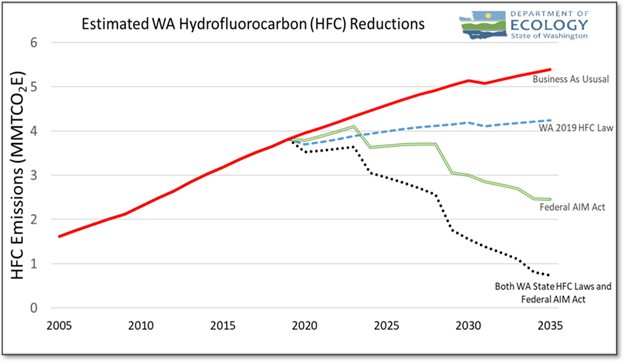Hydrofluorocarbon transition
In November 2023, we adopted a rule supporting the transition away from using potent greenhouse gases known as hydrofluorocarbons (HFCs) in products and equipment.
HFCs are chemicals made up of hydrogen, fluorine, and carbon. They're commonly used in air conditioning and refrigeration, in producing insulating foams, and as propellants. These greenhouse gases are a short-lived “super pollutant” and can be thousands of times more powerful than carbon dioxide.
HFCs were designed specifically because they were thought to be less harmful to the earth's protective ozone layer. But now HFCs are quickly building up in the atmosphere. If their use isn't stopped, HFC emissions will increase to 7-19% of global greenhouse gas emissions by 2050. In Washington, HFCs account for about 4% of overall greenhouse gas emissions.
New program information
The new Hydrofluorocarbons adopted rule language guidebook is now published.
The recorded informational webinars and registration training are posted below.
- Video of the Jan. 9, 2024, webinar about the prohibitions on the use of certain HFCs
- Video of the Jan. 11, 2024, webinar about the Refrigerant Management Program
- Video of RAMP registration, step-by-step process for registering in Refrigeration and Air-Conditioning Management Platform (RAMP).
2021 HFC legislative changes
In May 2021, the Governor signed the Hydrofluorocarbons — Emissions Reduction, Chapter 70A.60 RCW, which expands on the 2019 HFC restrictions. The new law directs us to:
- Set a maximum global warming potential (GWP) threshold for hydrofluorocarbons used in ice rinks.
- Establish a refrigerant management program to address refrigerant emissions from large air conditioning and refrigeration equipment.
- Recommend to the Legislature by Dec. 1, 2021, how to manage end-of-life and disposal of refrigerants.
The law allows us to:
- Set a maximum global warming potential (GWP) threshold for hydrofluorocarbons used in:
- New stationary air conditioning equipment.
- New stationary refrigeration equipment.
Starting July 25, 2021, the new law bans the sale and purchase of certain HFC refrigerants with high-global-warming potential as well as non-essential consumer products (like air horns and noisemakers) which contain high global-warming-potential refrigerants.
The law also:
- Requires the Washington Department of Enterprise Services (DES) to establish a lower cost for state purchasing of recycled refrigerants.
- Requires the State Building Code Council to develop new standards allowing substitutes with lower global warming potential than HFCs.
Reaching our reduction target
HFC emission reductions are key to achieving the state’s overall goal of reducing greenhouse gas emissions to net zero by 2050. When combined with complementary federal laws, we project a 75% reduction in Washington HFC emissions by 2035.

Projected hydrofluorocarbon emission reductions in Washington through implementation of new laws. Emissions measured in million metric tons of carbon dioxide equivalent (MMTCO2E)
Related links
- Hydrofluorocarbons rulemaking, Chapter 173-443 WAC
- Hydrofluorocarbons – Emissions Reduction, Chapter 70A.60 RCW
- EPA's SNAP information
- EPA — Montreal Protocol Amendments
Contact information
Technical Contact:
Tammy Dumitrescu
Environmental Specialist
HFC@ecy.wa.gov
360-338-2606
Media Contact:
Caroline Halter
Communications Manager
Caroline.Halter@ecy.wa.gov
564-669-8947
Stay informed
Join our email list

